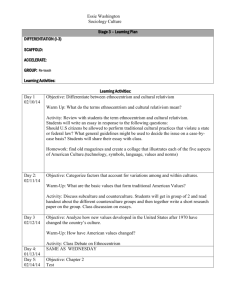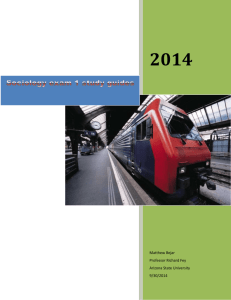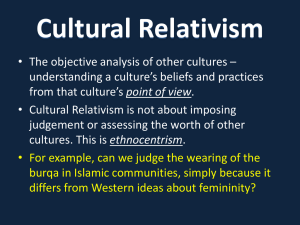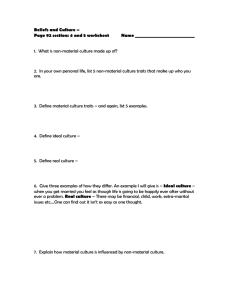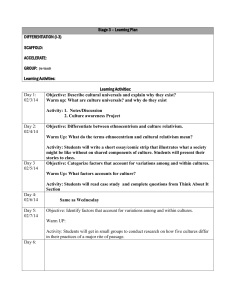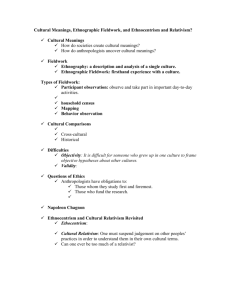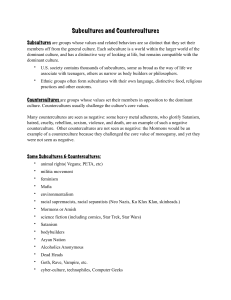Technology, Cultural Change, Counter Cultures, Subcultures, and
advertisement
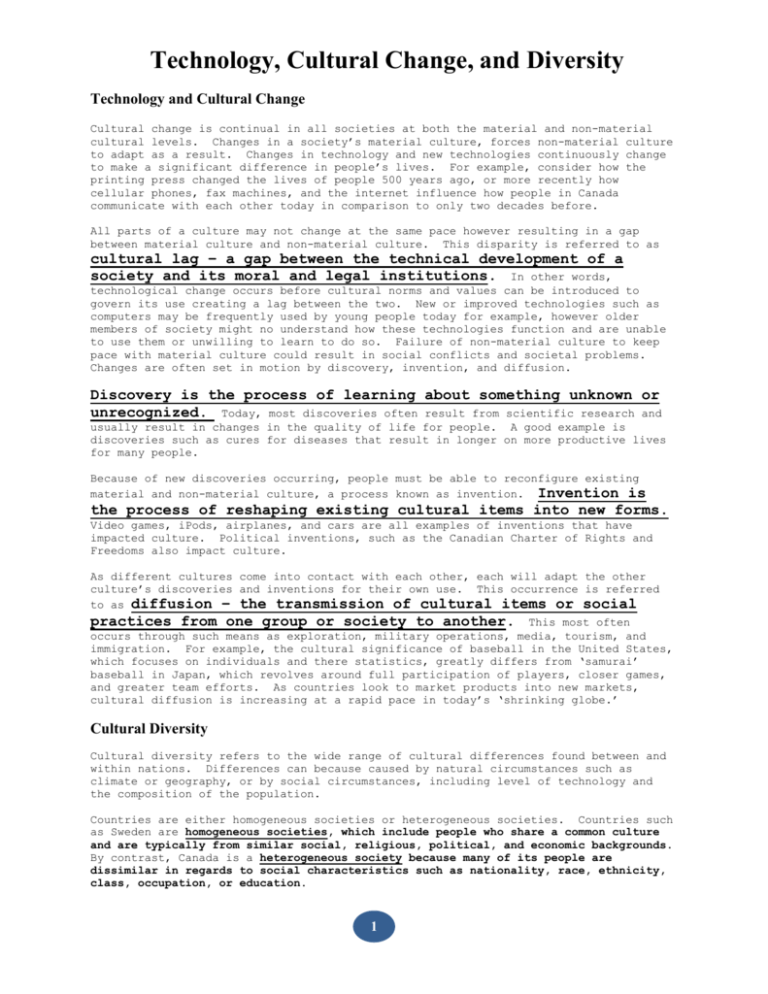
Technology, Cultural Change, and Diversity Technology and Cultural Change Cultural change is continual in all societies at both the material and non-material cultural levels. Changes in a society’s material culture, forces non-material culture to adapt as a result. Changes in technology and new technologies continuously change to make a significant difference in people’s lives. For example, consider how the printing press changed the lives of people 500 years ago, or more recently how cellular phones, fax machines, and the internet influence how people in Canada communicate with each other today in comparison to only two decades before. All parts of a culture may not change at the same pace however resulting in a gap between material culture and non-material culture. This disparity is referred to as cultural lag – a gap between the technical development of a society and its moral and legal institutions. In other words, technological change occurs before cultural norms and values can be introduced to govern its use creating a lag between the two. New or improved technologies such as computers may be frequently used by young people today for example, however older members of society might no understand how these technologies function and are unable to use them or unwilling to learn to do so. Failure of non-material culture to keep pace with material culture could result in social conflicts and societal problems. Changes are often set in motion by discovery, invention, and diffusion. Discovery is the process of learning about something unknown or unrecognized. Today, most discoveries often result from scientific research and usually result in changes in the quality of life for people. A good example is discoveries such as cures for diseases that result in longer on more productive lives for many people. Because of new discoveries occurring, people must be able to reconfigure existing material and non-material culture, a process known as invention. Invention is the process of reshaping existing cultural items into new forms. Video games, iPods, airplanes, and cars are all examples of inventions that have impacted culture. Political inventions, such as the Canadian Charter of Rights and Freedoms also impact culture. As different cultures come into contact with each other, each will adapt the other culture’s discoveries and inventions for their own use. This occurrence is referred to as diffusion – the transmission of cultural items or social practices from one group or society to another. This most often occurs through such means as exploration, military operations, media, tourism, and immigration. For example, the cultural significance of baseball in the United States, which focuses on individuals and there statistics, greatly differs from ‘samurai’ baseball in Japan, which revolves around full participation of players, closer games, and greater team efforts. As countries look to market products into new markets, cultural diffusion is increasing at a rapid pace in today’s ‘shrinking globe.’ Cultural Diversity Cultural diversity refers to the wide range of cultural differences found between and within nations. Differences can because caused by natural circumstances such as climate or geography, or by social circumstances, including level of technology and the composition of the population. Countries are either homogeneous societies or heterogeneous societies. Countries such as Sweden are homogeneous societies, which include people who share a common culture and are typically from similar social, religious, political, and economic backgrounds. By contrast, Canada is a heterogeneous society because many of its people are dissimilar in regards to social characteristics such as nationality, race, ethnicity, class, occupation, or education. 1 Immigration contributes to cultural diversity in a society. Immigration can cause feelings of frustration and hostility, especially in those who feel threatened by the changes that large numbers of immigrants may produce. Often people are intolerant of others whom are different from themselves. When societal tensions rise, people may look for others to place blame upon or single out because they are ‘outsiders.’ This occurrence is evident in Canada today because of the ongoing ‘reasonable accommodation’ hearings that have been held in Quebec and Ontario by their respective provincial governments. Although the hearings have found many Canadians to be completely open to and accepting of cultural diversity, other Canadians feel that new immigrants to Canada need to assimilate more fully into ‘Canadian’ culture Diversity has created unique challenges for Canadians to define and maintain a unique Canadian culture. In fact, what is unique to Canada is the distinct number of subcultures that make up our Canadian culture. A subculture is a group of people who share a distinctive set of cultural beliefs and behaviours that differ in some way from that of the larger society. In Canada, regional, ethic, class, language, and religious subcultures combine to produce a highly diverse society. Other groups in Canada might be people who are considered deviant or marginalized from the larger society. Some subcultures actively oppose the larger society. This occurrence is known as counterculture – a group that strongly rejects dominant societal values and norms and seeks alternative lifestyles. Young people are more likely to join these groups. Flower children of the 1960s, members of non mainstream religious sects, and cults are all examples of countercultures. Some countercultures such as neo-nazi skinheads and the Ku Klux Klan are more radical and engage in revolutionary political activities and engage in hate crimes. Culture Shock Culture shock is the disorientation that people feel when they encounter cultures radically different from their own. They believe they cannot depend on their own taken-for-granted assumptions about life. Culture shock can occur when people travel to another society and do not know how to respond to that setting. Imagine visiting with the Yanomanö (pronounced yah-noh-MAH-mah) tribe from South America. They have no written language, system of numbers, or calendar. They lead a nomadic lifestyle, carrying everything they own on their backs. They wear no clothes and paint their bodies. Women insert slender sticks through holes in the lower lip and through the pierced nasal septum. It would be difficult for you to adjust from your lifestyle in Canada to that of the Yanomanö. Ethnocentrism and Cultural Relativism When observing other cultures, people tend to use their own culture as a benchmark from which to judge the behaviours of others. This approach is referred to as ethnocentrism – the tendency to regard one’s own culture and group as the standard, and thus superior, whereas all other groups are seen as inferior. Ethnocentrism can be either positive or negative. cultural relativism – the belief that the behaviours and customs of any culture must be viewed and analyzed by the culture’s own standards. Cultural Relativism is a An alternative to ethnocentrism is philosophy that believes that when it comes to matters of right and wrong, and other values of a moral nature, that there are no absolutes, or any fixed truth, but rather that all is relative. 2 ‘Good’ and ‘bad’ or ‘right’ and ‘wrong’ are merely assigned and psycho-emotively attached to beliefs and actions by the culture in which one lives. ‘Good’ or ‘right’ is simply what is socially approved of in that culture by the majority over time and is therefore a matter of social convention. What constitutes something being considered ‘bad,’ ‘wrong,’ or even ‘evil,’ is therefore also culturally relative. Therefore no belief or action is inherently good or bad. It is rather either acceptable or taboo within that given culture. Thus, we should all therefore learn to become accommodating of the beliefs of other cultures and suspend personal judgment, because the real issue is not ‘good’ or ‘bad,’ but simply a matter of difference. For example, cattle are considered sacred in India and are not killed and eaten. From an ethnocentric viewpoint, a person could conclude that cow worship is part of the cause of widespread hunger, malnutrition, and poverty in that country. However, in India it is taboo to kill cattle. Live cattle are considered to be an important component of India’s economic system because they have more important uses than as a direct source of food. Looking at this from a cultural relativist perspective, in India, cattle serve two main purposes. Oxen, the neutered offspring of cows, are used to power the plows and their manure is used for fuel and fertilizer. Cows also provide milk, and leather and floor coverings upon their deaths. It is important that remember that culture must be viewed from the standpoint of those who live in a particular society. Cultural relativism can also have a downside. It may be used to excuse customs and behaviours, such as cannibalism, that may violate basic human rights. 3


